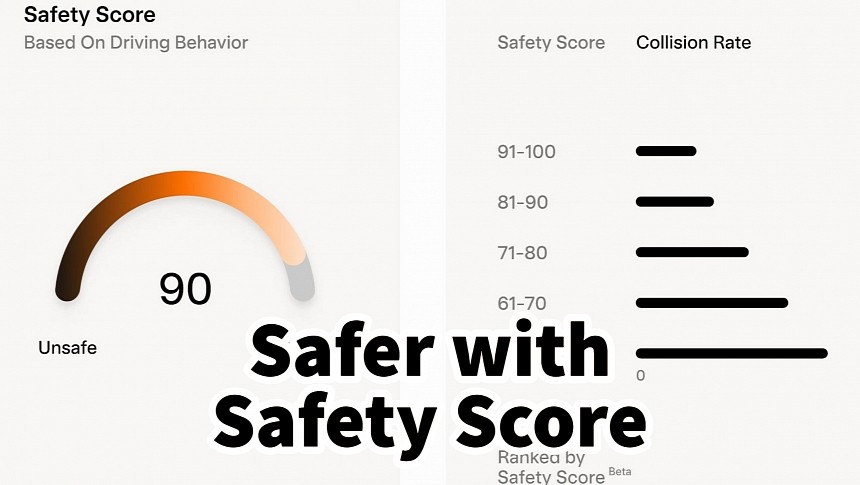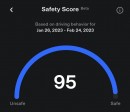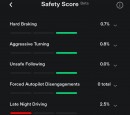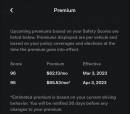Despite critics, Tesla's Safety Score serves its purpose of making people drive safer. Tesla's Impact Report 2022 shows that those with access to Safety Score are less likely to be involved in a crash than those that haven't opted for Tesla Insurance.
Tesla designed the Safety Score as a tool to assess driving behavior to know how much to charge owners for insurance. By analyzing key driving parameters, including braking, turning, unsafe following, and speeding, Tesla can tell who is driving dangerously. Then, it jacks up the insurance prices for those drivers accordingly. The Safety Score has also been used to grant the safest drivers access to the FSD Beta program.
Many have criticized Tesla's Safety Score tool, saying it counts the car's mistakes, such as phantom braking and false-positive forward-collision warnings, as driver's errors. This has consequences, as the insurance prices increase with every Safety Score deterioration. Others have shown that even driving after 10 PM counts as dangerous driving, affecting Safety Score. This goes against US statistics showing that the most dangerous driving time is before 10 PM.
Despite all these complaints, the Safety Score makes people drive more carefully. Knowing you will pay more for insurance is an effective deterrent to aggressive driving. This is made clear in Tesla's Impact Report 2022, which details accident statistics for those who use Safety Score. According to Tesla, people who have enabled Safety Score are less likely to crash than those who don't have access to this tool.
The collision rates drop significantly for drivers with the highest scores. People with a Safety Score of 91 or above are twice less likely to crash than those with a 61-70 score. This proves the connection between the score awarded by the app and the driver's behavior. It also shows the latest app version, Safety Score 2.0, has become very good at assessing driving.
Even without any driver-assist systems engaged, Tesla drivers are twice less likely to crash than the average American driver. Tesla shows that the collision rate for its drivers that don't use Autopilot or FSD Beta is 0.68 crashes per million miles. Having FSD Beta engaged during city driving lowers the rate to 0.31 crashes per million miles. Thanks to the safer environment, driving on highways with Autopilot on is the safest, at 0.18 crashes per million miles.
The results align with previous reports regarding FSD Beta safety, which showed one crash per 3.2 million miles. The worse safety under FSD Beta compared to Autopilot indicates differences between city driving (FSD Beta) and highway driving (Autopilot). Since FSD Beta V11 is now using a unified stack for highway driving, we might see a marked change in how Tesla reports crashes in the future. Regardless of the driver assist system, driving in the city is always more dangerous than on a highway.
Many have criticized Tesla's Safety Score tool, saying it counts the car's mistakes, such as phantom braking and false-positive forward-collision warnings, as driver's errors. This has consequences, as the insurance prices increase with every Safety Score deterioration. Others have shown that even driving after 10 PM counts as dangerous driving, affecting Safety Score. This goes against US statistics showing that the most dangerous driving time is before 10 PM.
Despite all these complaints, the Safety Score makes people drive more carefully. Knowing you will pay more for insurance is an effective deterrent to aggressive driving. This is made clear in Tesla's Impact Report 2022, which details accident statistics for those who use Safety Score. According to Tesla, people who have enabled Safety Score are less likely to crash than those who don't have access to this tool.
The collision rates drop significantly for drivers with the highest scores. People with a Safety Score of 91 or above are twice less likely to crash than those with a 61-70 score. This proves the connection between the score awarded by the app and the driver's behavior. It also shows the latest app version, Safety Score 2.0, has become very good at assessing driving.
Even without any driver-assist systems engaged, Tesla drivers are twice less likely to crash than the average American driver. Tesla shows that the collision rate for its drivers that don't use Autopilot or FSD Beta is 0.68 crashes per million miles. Having FSD Beta engaged during city driving lowers the rate to 0.31 crashes per million miles. Thanks to the safer environment, driving on highways with Autopilot on is the safest, at 0.18 crashes per million miles.
The results align with previous reports regarding FSD Beta safety, which showed one crash per 3.2 million miles. The worse safety under FSD Beta compared to Autopilot indicates differences between city driving (FSD Beta) and highway driving (Autopilot). Since FSD Beta V11 is now using a unified stack for highway driving, we might see a marked change in how Tesla reports crashes in the future. Regardless of the driver assist system, driving in the city is always more dangerous than on a highway.
Tesla exists to accelerate the transition to sustainable energy.
— Tesla (@Tesla) April 24, 2023
Impact Report 2022 → https://t.co/Zj8onKMJrT
—
2022 Highlights
Last year, our customers avoided releasing about 13.4 million metric tons of CO2e into our atmosphere ????
Tesla vehicle emissions are significantly… pic.twitter.com/2CvMNPGeVh








